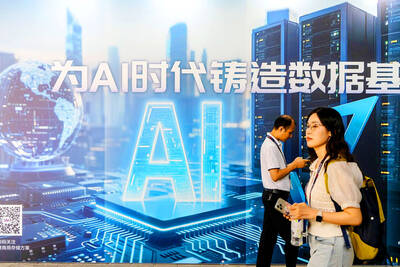China’s COSCO Group (中國海運集團), owner and operator of one of the largest container ships in the world, is eyeing Kaohsiung Harbor as a transshipment center to bolster transshipping and logistics services.
The 10,000 twenty-foot equivalent unit (TEU) COSCO Oceania anchored at Kaohsiung Harbor on Wednesday after the historic inauguration of direct cross-Taiwan Strait shipping links on Monday, unloading around 50 containers and loading some 900 containers before heading for Hong Kong en route to Europe.
The COSCO Oceania, the largest container ship in Asia and one of the largest in the world, embarked from the Chinese port of Tianjin on Monday and arrived at Kaohsiung 55 hours later to become the first Chinese ship to visit a Taiwanese port via direct shipping links since 1949.
COSCO Group chairman Wei Jiafu (魏家福), who flew into Taiwan on Monday to witness the inauguration of the direct links, attended a reception at Kaohsiung Harbor yesterday and said that the COSCO Group was having an even bigger container ship built — a 13,500 TEU vessel to be named the COSCO Kaohsiung — which will ply its global routes with Kaohsiung Harbor as one of its key transshipping points.
Also speaking at the reception, Kaohsiung Harbor Administration Director-General Hsieh Ming-hui (謝明輝) said the harbor’s history would be rewritten when the COSCO Kaohsiung makes its maiden voyage to Kaohsiung Harbor in 2010.
Taiwan and China resumed daily direct passenger flights, cargo flights and shipping links on Monday. Ships can sail between 11 ports in Taiwan and 63 ports in China without being required to transit through a third region.

Taiwan Semiconductor Manufacturing Co (TSMC, 台積電) last week recorded an increase in the number of shareholders to the highest in almost eight months, despite its share price falling 3.38 percent from the previous week, Taiwan Stock Exchange data released on Saturday showed. As of Friday, TSMC had 1.88 million shareholders, the most since the week of April 25 and an increase of 31,870 from the previous week, the data showed. The number of shareholders jumped despite a drop of NT$50 (US$1.59), or 3.38 percent, in TSMC’s share price from a week earlier to NT$1,430, as investors took profits from their earlier gains

In a high-security Shenzhen laboratory, Chinese scientists have built what Washington has spent years trying to prevent: a prototype of a machine capable of producing the cutting-edge semiconductor chips that power artificial intelligence (AI), smartphones and weapons central to Western military dominance, Reuters has learned. Completed early this year and undergoing testing, the prototype fills nearly an entire factory floor. It was built by a team of former engineers from Dutch semiconductor giant ASML who reverse-engineered the company’s extreme ultraviolet lithography (EUV) machines, according to two people with knowledge of the project. EUV machines sit at the heart of a technological Cold

CHINA RIVAL: The chips are positioned to compete with Nvidia’s Hopper and Blackwell products and would enable clusters connecting more than 100,000 chips Moore Threads Technology Co (摩爾線程) introduced a new generation of chips aimed at reducing artificial intelligence (AI) developers’ dependence on Nvidia Corp’s hardware, just weeks after pulling off one of the most successful Chinese initial public offerings (IPOs) in years. “These products will significantly enhance world-class computing speed and capabilities that all developers aspire to,” Moore Threads CEO Zhang Jianzhong (張建中), a former Nvidia executive, said on Saturday at a company event in Beijing. “We hope they can meet the needs of more developers in China so that you no longer need to wait for advanced foreign products.” Chinese chipmakers are in

AI TALENT: No financial details were released about the deal, in which top Groq executives, including its CEO, would join Nvidia to help advance the technology Nvidia Corp has agreed to a licensing deal with artificial intelligence (AI) start-up Groq, furthering its investments in companies connected to the AI boom and gaining the right to add a new type of technology to its products. The world’s largest publicly traded company has paid for the right to use Groq’s technology and is to integrate its chip design into future products. Some of the start-up’s executives are leaving to join Nvidia to help with that effort, the companies said. Groq would continue as an independent company with a new chief executive, it said on Wednesday in a post on its Web